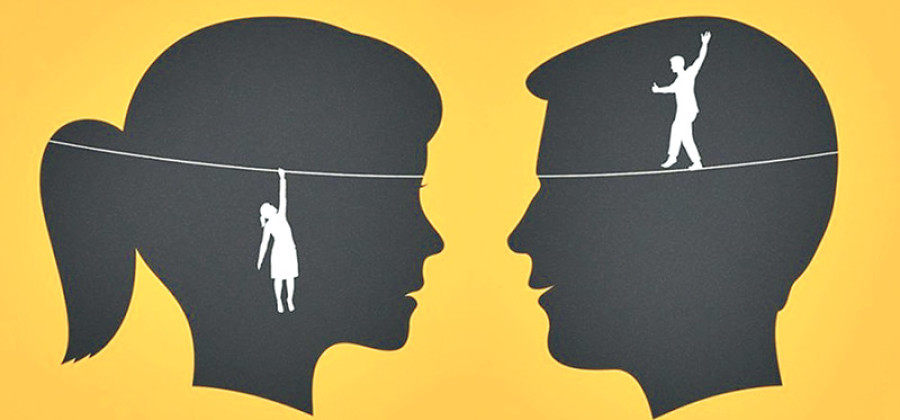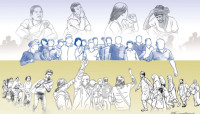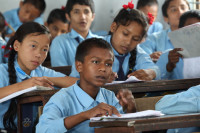Opinion
Bridging the gender gap
Everyone should be given equal opportunities so that they can be assets to the nation building process
Samaya Lama
According to the World Economic Forum’s Global Gender Gap Report of 2017, Nepal ranks 111 out of 144 countries. The World Economic Forum measures gender gaps on the basis of four thematic dimensions: Economic participation and opportunity, educational attainment, health and survival, and political empowerment. The Global Gender Gap index is measured from a scale of 0 to 1. According to this report, in South Asian countries, Bangladesh scored first in terms of narrowing the gender gap, followed by the Maldives, India, Sri Lanka, Nepal, Bhutan and Pakistan. Globally, Iceland is in the first position in terms of narrowing the gender gap, and Yemen is at the bottom. In 2016, among 144 countries, Nepal’s rank in economic participation and opportunity was 115/144, 123/144 in educational attainment, 92/144 in health and survival, and 68/144 in political empowerment. In 2017, among 144 countries, Nepal’s rank in economic participation and opportunity is 110/144, 116/144 in educational attainment, 116/144 in health and survival, and 80/144 in political empowerment.
The report further explains that Nepal has made notable improvements in women’s access to ministerial positions and the estimated share of women’s income whereas it has surprisingly stepped down in health and survival and in political empowerment than in comparison to the previous year.
Achieving goals
In 2006, Nepal settled its Maoist insurgency via the Comprehensive Peace Accord (CPA), which was the result of the second people’s movement (Jana Andolan II). This marked Nepal’s official transformation towards an inclusive democracy. The restoration of peace gave Nepal opportunities to strengthen its approach to a development agenda.
After 1990, Nepal has been partnering with many development agencies to deliver projects in Nepal. Since then, foreign aid has been the lifeline of Nepal’s development process. In 2000, Nepal signed the Millennium Development Goals (MDGs)—which were a part of the broader UN development agenda till 2015. Nepal achieved significant progress in MDGs 2, 4 and 5. Now, we are currently under the UN Sustainable Development Goals (SDGs) which will continue till 2030.
Most of the global development literature suggests that women’s issues are the cross-cutting issues of the entire 17 goals of the SDGs. So, without empowering women, these goals can’t be achieved. Underlining SDG 5, Nepal has passed significant bills for domestic violence, sexual harassment at workplace, rights to parental property, full inheritance rights to a widow, rights for a wife in husband’s property, inheritance rights to divorced women, rights to abortion of up to 12 weeks pregnancy, abortion rights at any time in special situations. Nepal is also one of the few countries in the world to provide rights and protection to its lesbian, gay, bisexual, and transgender (LGBT) community in its constitution. In 2010, the election commission added third gender options in its list of voter registration. In 2011, Nepal was the first country to include third gender statistics in its federal census. In addition to that, the government issued passports that recognise a third gender.
Though Nepal has passed a significant amount of bills and action plans to narrow its gender gap, there is still a lot of work to do. Most of the rights and laws are not implemented effectively in reality. Today’s world is more likely to be governed by knowledge and skills rather than unscientific approaches. In this growing competitive world, everyone should be given equal opportunities to strengthen and build their capacity so that they can be assets to the nation building process. Without integrating girls and women in the mainstream governance system of Nepal, we are likely to lose their ideas, talents, skills and critical thinking. We can create more effective initiatives to ensure the rights and opportunities of girls and women.
Empowering men
Nepal is a patriarchal society where socio-economic and political power is captured by men. Till now, we have designed projects and programmes that strongly involve women for women development. We underlined the role of men in women empowerment. Since, men and women are the two pivotal factors of running a society, empowering women only is limited in terms of achieving full-fledged women development. We need to ensure the participation of males in every gender orientation programme for better results. Our contemporary practice shows that we are only working on women-women models for women empowerment. But the time has come to work on women-men models. Giving priority to only women has given them strength, skill and knowledge but it would be much better if men were also educated about women empowerment and their roles to help women. Primarily, males are the ultimate power holders in society and trying to close the gender gap without the participation of men will have limited impacts. If we could integrate men in women empowerment projects, then we will have a strong impact in closing the gender gap.
Women in tech
Traditional women empowerment projects include training women in sewing, animal husbandry and agriculture. In this technologically dominated world, it seems that projects like these have a limited impact within their communities. Though these kinds of projects have provided support for most women in tackling poverty and lessening their dependency on men, in today’s globalised world, our approach should focus on the globalisation of women’s impact. Small scale projects like sewing, animal husbandry and agriculture have only helped them to build locally. Now, the time has come to globalise their work. The Nepali government can collaborate with UN agencies and other development partners to provide women with technical training so that they can take their work international. Some of the technical training includes website building, graphic designing, animation, and digital post card making. Technology has a global market. UN agencies can provide training and can establish venture capital funds to provide a source for women tech start-ups. For example, after receiving training on website building, women in a remote district such as Kalikot can start their own websites and build start-ups with the help of the venture capital provided by the UN agencies. The traditional local women’s cooperatives in the community can be modified into venture capital funds to provide support for those women who wants to start tech start-ups in their community. This kind of initiative will make them more independent and confident so that they can compete in an international market.
Today’s world is dominated by skills, networking and capital. Our traditional approach in women empowerment either includes providing skills to women or cash grants. But we have not been able to provide them with skills, networking and capital in a parallel manner. This has made it very difficult to close our gender gap. Through start-ups such as these, we will give women skills to work with technology, and they will have an international network through which they can sell their products and earn capital through global competition. In this way, we can close gender gap.
Lama is a director of Garjan-Nepal, a non-profit organisation based in Nepal




 13.12°C Kathmandu
13.12°C Kathmandu










